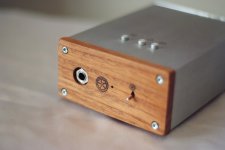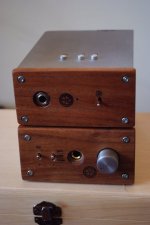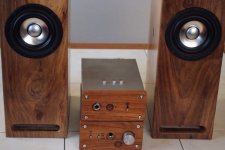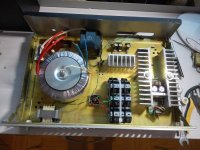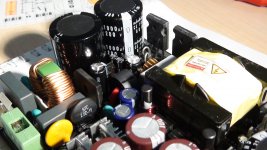Actually the case had an IEC hole, and fuse hole already drilled. I didn't put a fuse, so the hole is left empty.Gribb - a nice looking amp with tidy internal layout. I like the use of speaker cab. receded binding post panels. I don't like the use of self tappers though!
It looks like you drilled the case for a mains fuse holder but have not used one. Why?
What is the mains safety earth connected to? It should be connected to the case as close as possible to the mains input socket.
The main earth is connected to the case directly around the IEC filter hole. I fit very very tightly (the paint has been removed).
The 240V cable that run from the IEC to the soft start is shielded. The shield is connected to earth at both end to prevent electromagnetic radiation to neighbouring cards.
I agree with you about the screws, those are actually for wood… I'll replace with black and shorter ones later.
This one HIFI 2000 400mm 3U Chassis - 10mm front Black - AudiophonicsGrib, whose enclosure?
I haven't have had the time to try in my acoustically treated room with a decent DAC yet, so I can't tell. I just tested the output power in my living room, the power is definitely here, very low noise floor.Grib - nice work, does it sound as good as it looks ?
Ideally it should be measured with an Audio Precision, if someone in France has one and is interested it measuring it, that'd be great 🙂
Last edited:
Great looking amps you guys have, one question though. Can I use wood to build an amp enclosure? I haven't seen a lot of people do it and I'm wondering why... I think it could look dope.
Well as you probably know.
Metal is conducting and therefore shielding, wood is not.
Shielding is good for all electronics, but especially switching electronics for not "poluting" the surrounding with noise (electromagnetic).
Metal is also good at transfering and handling heat (transfering especially alu and copper), therefore can be used for heat control. Wood on the other hand .... well wood burns 😉
... a good compromise; melat box with wooden front 🙂
Metal is conducting and therefore shielding, wood is not.
Shielding is good for all electronics, but especially switching electronics for not "poluting" the surrounding with noise (electromagnetic).
Metal is also good at transfering and handling heat (transfering especially alu and copper), therefore can be used for heat control. Wood on the other hand .... well wood burns 😉
... a good compromise; melat box with wooden front 🙂
wood burns - yes, but at very high temperature.
Many tube amplifiers are in wood cases. But, they are also in metalcase. There are many DIY tube amp build with wood outside, and metal inside. And it does look good.
Many tube amplifiers are in wood cases. But, they are also in metalcase. There are many DIY tube amp build with wood outside, and metal inside. And it does look good.
My new Volt+ ( TPA3118 ) atop it's Astron linear regulated PSU. This is the best sounding of all my TPA amps.


"Baking Tray" 7-channel Home Theater Amplifier
[image]Image:"Baking Tray" Amplifier - Front|none[/image]
I've just finished building my 7-channel home theatre power amplifier. I used seven LJM L15D Class-D IRS2092 kit boards which I assembled myself. They're powered by two 500W +/-55V SMPS's, with separate speaker protection modules (also kits) powered from the SMPS +15V line, and with a separately powered 5V IR remote on/off relay circuit, so I can control it from my Harmony Remote along with the rest of my system (plus a manual on/off on the front of the amp)
The Right, Centre and Left/Right Surround channels are powered off one SMPS, and the Left and both Rear channels are powered off the other SMPS. I built simple op-amp phase inverters for the inputs of the Centre, Surround and Right-Back channels and reversed those speaker connections, to avoid any bus pumping.
I use an Onkyo 7.1 AV receiver for input switching and digital signal processing. I had to modify it to provide pre-amp outputs via RCA sockets on the back panel (with optional wire links to RCA power amp inputs, in case I want to revert or sell it in the future!). But when I connected it, I found I had faint but annoying hum on some channels, which I could only eliminate by 'floating' the power amp's ground (i.e a virtual ground, rather than connected it to the chassis - which is of course earthed to avoid nasty surprises!). Other sources such as iPod and DVD player were OK though, so I'm still working on the hum problem, as I'd prefer the virtual ground to be properly earthed too, but I may have to leave things as they are if I can't resolve it.
As for the case, I made this from three non-stick steel baking trays costing NZ$6 each - one for the top, one for the bottom and one cut in half with the edges removed for the front and back panels. The side pieces are walnut-stained pine. The front indicators are pieces of thin TOSLink cable, connected to the onboard LEDs via a bit of tubing, and exposed through LED bezels, which looks really neat and keeps them not too bright for a darkened living room. The seven blue indicators show the L15D modules are working. The four red indicators below them light if the speaker protection is triggered, and the two indicators by the power button are for standby and power-on.
I decided to fit a 120mm computer fan to the top of the case, using the 12V output from one of the SMPS's, undervolted to around 7V via an inline resistor, for some (almost) silent cooling as the internals are a bit cramped due to the limited size of the baking trays. It runs fairly warm but not too hot; I can easily touch all of the heatsinks after several hours of running - I'm waiting for a digital thermometer to arrive from China so I can check actual temperatures but it seems OK.
I think it looks not bad for my first budget 'homebrew' attempt, but more importantly, it sounds so very much better than the internal Onkyo power amps - smoother, richer, deeper bass, brighter highs. This is very noticeable when I run in 'Pure Audio' (i.e. no DSP) mode, when the Onkyo always sounded thin and flat - this amp sounds really full and rich. Also performs great in full 7-channel surround mode. I'm planning to replace the L15D 220uF buffer caps with better 820uF ones, and the input caps with Elna Silmics, as in another thread I saw this can improve the sound quality further. But for now, I'm just sitting back and enjoying it.
Here are photos of the back and the internals.
[image]Image:"Baking Tray" Amplifier - Rear|none[/image]
[image]Image:"Baking Tray" Amplifier - Internal|none[/image]
[image]Image:"Baking Tray" Amplifier - Front|none[/image]
I've just finished building my 7-channel home theatre power amplifier. I used seven LJM L15D Class-D IRS2092 kit boards which I assembled myself. They're powered by two 500W +/-55V SMPS's, with separate speaker protection modules (also kits) powered from the SMPS +15V line, and with a separately powered 5V IR remote on/off relay circuit, so I can control it from my Harmony Remote along with the rest of my system (plus a manual on/off on the front of the amp)
The Right, Centre and Left/Right Surround channels are powered off one SMPS, and the Left and both Rear channels are powered off the other SMPS. I built simple op-amp phase inverters for the inputs of the Centre, Surround and Right-Back channels and reversed those speaker connections, to avoid any bus pumping.
I use an Onkyo 7.1 AV receiver for input switching and digital signal processing. I had to modify it to provide pre-amp outputs via RCA sockets on the back panel (with optional wire links to RCA power amp inputs, in case I want to revert or sell it in the future!). But when I connected it, I found I had faint but annoying hum on some channels, which I could only eliminate by 'floating' the power amp's ground (i.e a virtual ground, rather than connected it to the chassis - which is of course earthed to avoid nasty surprises!). Other sources such as iPod and DVD player were OK though, so I'm still working on the hum problem, as I'd prefer the virtual ground to be properly earthed too, but I may have to leave things as they are if I can't resolve it.
As for the case, I made this from three non-stick steel baking trays costing NZ$6 each - one for the top, one for the bottom and one cut in half with the edges removed for the front and back panels. The side pieces are walnut-stained pine. The front indicators are pieces of thin TOSLink cable, connected to the onboard LEDs via a bit of tubing, and exposed through LED bezels, which looks really neat and keeps them not too bright for a darkened living room. The seven blue indicators show the L15D modules are working. The four red indicators below them light if the speaker protection is triggered, and the two indicators by the power button are for standby and power-on.
I decided to fit a 120mm computer fan to the top of the case, using the 12V output from one of the SMPS's, undervolted to around 7V via an inline resistor, for some (almost) silent cooling as the internals are a bit cramped due to the limited size of the baking trays. It runs fairly warm but not too hot; I can easily touch all of the heatsinks after several hours of running - I'm waiting for a digital thermometer to arrive from China so I can check actual temperatures but it seems OK.
I think it looks not bad for my first budget 'homebrew' attempt, but more importantly, it sounds so very much better than the internal Onkyo power amps - smoother, richer, deeper bass, brighter highs. This is very noticeable when I run in 'Pure Audio' (i.e. no DSP) mode, when the Onkyo always sounded thin and flat - this amp sounds really full and rich. Also performs great in full 7-channel surround mode. I'm planning to replace the L15D 220uF buffer caps with better 820uF ones, and the input caps with Elna Silmics, as in another thread I saw this can improve the sound quality further. But for now, I'm just sitting back and enjoying it.
Here are photos of the back and the internals.
[image]Image:"Baking Tray" Amplifier - Rear|none[/image]
[image]Image:"Baking Tray" Amplifier - Internal|none[/image]
@serafis
Wow! I lift my hat off for you, that is some serious work and a lot of thought put down into that build ��.
Wow! I lift my hat off for you, that is some serious work and a lot of thought put down into that build ��.
Thanks - getting it all to fit in the limited footprint of the baking trays neatly with enough space for ventilation and wiring was probably the biggest problem, including keeping the power, speaker and signal lines as far away from each other as possible. Also keeping mains voltages away from the rest of it - the SMPS's are mounted on brass standoffs, with thin plastic sheet (kitchen cutting board, in fact!) underneath to avoid any possibility of arcing to the chassis. Drilling neat holes for the cooling fan and back vents took a bit of time too. Also I managed to blow up one L15D and one SMPS by failing to note that the speaker protection modules had common grounds, so when I reversed speaker connection on one board it was shorted out. Lesson - check speakers for shorts before powering up! Managed to fix the L15D with new IRS2092, MOSFETs and zeners, but the SMPS is a write-off at the moment, so had to buy a new one.
Also thanks to doctordata (Rens) for his ideas for the phase inverters () which I built on a bit of prototype board as I don't have facilities to make PCBs here, and to other helpful hints in that thread.
Also thanks to doctordata (Rens) for his ideas for the phase inverters () which I built on a bit of prototype board as I don't have facilities to make PCBs here, and to other helpful hints in that thread.
... there should have been a link to phase inverters in the empty brackets in my last post, it's http://www.diyaudio.com/forums/class-d/191739-my-design-l20d-irs2092-irfi4020h-200w8r-38.html#post2951879
Some more miniatures...
This time, it's the STA333BW USB "full digital" ebay amp, very slightly modded, in a new enclosure. Also a nice DAC, FX6 in a new box, and some new small speakers, just to complete the picture 🙂
This time, it's the STA333BW USB "full digital" ebay amp, very slightly modded, in a new enclosure. Also a nice DAC, FX6 in a new box, and some new small speakers, just to complete the picture 🙂
Attachments
Thanks - getting it all to fit in the limited footprint of the baking trays neatly with enough space for ventilation and wiring was probably the biggest problem, including keeping the power, speaker and signal lines as far away from each other as possible. Also keeping mains voltages away from the rest of it - the SMPS's are mounted on brass standoffs, with thin plastic sheet (kitchen cutting board, in fact!) underneath to avoid any possibility of arcing to the chassis. Drilling neat holes for the cooling fan and back vents took a bit of time too. Also I managed to blow up one L15D and one SMPS by failing to note that the speaker protection modules had common grounds, so when I reversed speaker connection on one board it was shorted out. Lesson - check speakers for shorts before powering up! Managed to fix the L15D with new IRS2092, MOSFETs and zeners, but the SMPS is a write-off at the moment, so had to buy a new one.
Also thanks to doctordata (Rens) for his ideas for the phase inverters () which I built on a bit of prototype board as I don't have facilities to make PCBs here, and to other helpful hints in that thread.
Very nice build ! Hope you enyoy it as much as I do !
L15D is a very good amp . What power supplys do you use ?
Cheers ,
Rens
Very nice build ! Hope you enyoy it as much as I do !
L15D is a very good amp . What power supplys do you use ?
Cheers ,
Rens
Hi Rens,
Yes it's a great amp - I'm surprised how much better it sounds than the Onkyo (TX-SR606) internals, I'm really enjoying 're-discovering' my music and music video collection.
It's difficult and expensive to get any sort of componentry here in New Zealand and shipping from US or Europe is very costly, so things like the Abletecs that others have recommended are out of my price range; most of my stuff has to come from China. The power supplies I used were +/-55V 500W SMPS boards like this at around US$35 (free shipping):

These also have +/-15V and +12V rails, and can be found at ebay or Aliexpress.
They work fine; voltage on both boards measures rock solid at +/-56.5V (with 236V measured input - think my DMM reads a bit high!), and they run very cool, but the short-circuit protection is maybe not the greatest - when one of the L15D's blew its MOSFETs and shorted out, the PSU made strange noises for a few seconds and then blew (exploded, actually) the fuse, also blew its MOSFETs and driver module. The Aliexpress seller let me have a new driver module for $8 and I bought new MOSFETs, but I haven't been able to get it working again yet; but they're pretty cheap so I just bought another one (off ebay this time) for now.
While waiting for the replacement to arrive, for a while I was driving all seven channels off one SMPS - it coped fine at 'loud living room' listening levels for music and movies.
I'd recommend them as a cheap PSU for class-D amps - they come in a variety of dual-range voltages and are quite compact and easy to mount.
Cheers,
Jon.
You could consider Connexelectronic
They are highly regarded here on diyaudio. I have a SMPS PSU from this site, but haven't used it yet, so can't comment - but it looks very well build.
They are highly regarded here on diyaudio. I have a SMPS PSU from this site, but haven't used it yet, so can't comment - but it looks very well build.
You could consider Connexelectronic
Thanks - I did consider Connextric, they do look like very nice, well made units and have had great feedback. Just a bit out of the 'acceptance factor' price range for my hobby! Maybe for the next build though.... ("What 'next build'?" I hear her say!)😉
- Home
- Amplifiers
- Class D
- Class D Amp Photo Gallery

